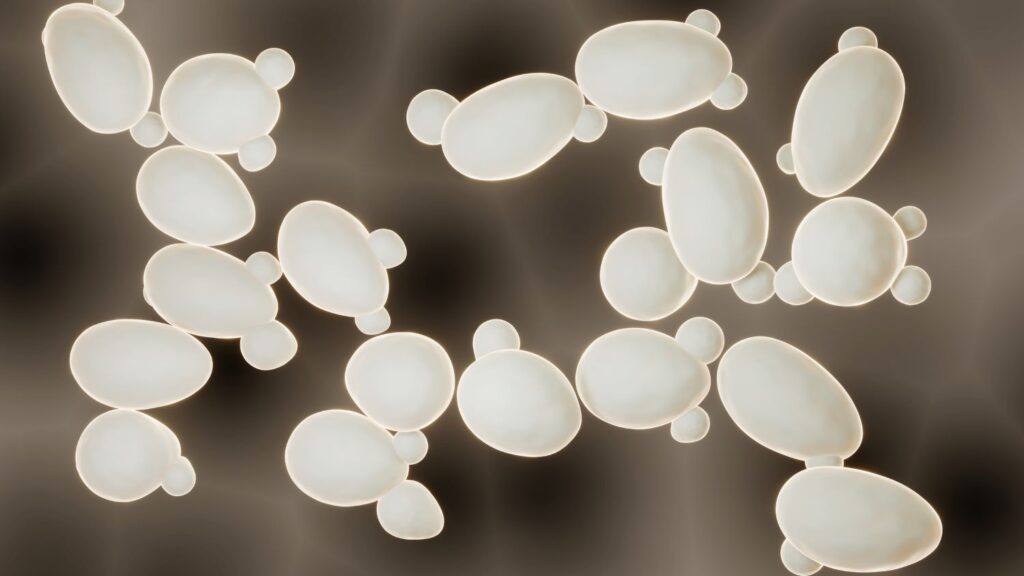Saccharomyces cerevisiae: definition and applications
From fermenting bread and beverages to advancing genetic research, Saccharomyces cerevisiae is a keystone of biology and industry. Saccharomyces cerevisiae is a titan of fermentation, converting sugars into carbon dioxide and alcohol, making it indispensable in baking, brewing, and biofuel production. Its genome was one of the first to be fully sequenced, providing invaluable insights into gene function, protein structure, and cellular processes. Beyond the laboratory, it plays a critical role in industries ranging from food production to renewable energy.
Introduction to Saccharomyces cerevisiae yeast
What is Saccharomyces cerevisiae?
Saccharomyces cerevisiae: definition
Saccharomyces cerevisiae is a single-cell organism belonging to thek kingdom of fungi. Althrough its common name, “baker’s yeast”, derives from its essential use in leavening bread dough, its genus name derives from the contraction of the Greek roots saccharo (sugar) and myces (fungus). As for its species name “cerevisiae”, that references “cervoise”, the Gauls’ traditional fermented barley or wheat beer.
Saccharomyces cerevisiae genome was fully sequenced in 1996 [1], revealing around 6,000 genes, with 5,570 predicted to code for proteins. It means that most of the genome is dedicated to producing functional proteins [2].
Origin and history of Saccharomyces cerevisiae
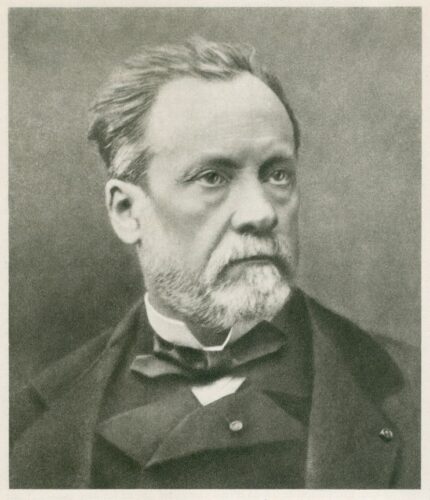 Saccharomyces cerevisiae, an anaerobic alcoholic fermentation agent identified in 1857 by the chemist Louis Pasteur as the principal alcoholic fermentation agent, Saccharomyces cerevisiae transforms the sugars in grains or fruit into alcohol and carbon dioxide in anaerobic conditions, that is to say, in an environment deprived of air. In the latter part of the 18th century, this transformation was identified by Adamo Fabbroni, an Italian agronomist, who suspected that a living substance, naturally present in the grape, was at the origin of wine fermentation.
Saccharomyces cerevisiae, an anaerobic alcoholic fermentation agent identified in 1857 by the chemist Louis Pasteur as the principal alcoholic fermentation agent, Saccharomyces cerevisiae transforms the sugars in grains or fruit into alcohol and carbon dioxide in anaerobic conditions, that is to say, in an environment deprived of air. In the latter part of the 18th century, this transformation was identified by Adamo Fabbroni, an Italian agronomist, who suspected that a living substance, naturally present in the grape, was at the origin of wine fermentation.
Controlling the culture of Saccharomyces cerevisiae in a given environment would not, however, take place until the end of the 19th century, thanks to the work of Robert Koch and Julius Richard Petri, who gave his name to the famous Petri dish. “From that point, the development of the modern fermentation industry became possible thanks to the isolation and selection of microorganisms of interest, which can be characterized according to nutritional needs and functions,” explains Gilles Stien, researcher at the Fermentation Design Process Center of Excellence from Lesaffre Institute of Science & Technology.
Importance in biology and industry
S. cerevisiae is one of the best-studied eukaryotic microbes among microbial communities. It is a powerhouse in biotechnology, serving as a cell factory for pharmaceuticals, bioactive, biochemical compounds, and industrial fermentation. S. cerevisiae‘s biotechnological value lies in its unique characteristics, such as its ability to ferment, produce alcohol and CO2, and withstand harsh conditions like high osmolarity and low pH. Its genome has been shaped over millennia through domestication, making it a key model organism in research and bioengineering.
Why is Saccharomyces cerevisiae so important?
Saccharomyces cerevisiae is a model organism in biology due to its simple eukaryotic structure. A comparative study of S. cerevisiae to 704 other organisms identifying pathways and processes where it serves as a reliable model for extrapolation [3]. This feature makes it ideal for studying cellular and molecular processes and pathways like DNA replication, gene expression, and protein interaction.
Did you know that almost 40% of the genes known to be involved in human genetic disease have a counterpart in yeast? S. cerevisiae is more than ever a relevant alternative model and tool for therapeutic research [4].
Fermentation at the heart of our daily diet
Today, the S. cerevisiae yeast is largely produced and used in the food industry due to its fermenting metabolism, total innocuity, rapid multiplication, ease of use, and nutritional benefits.
Biology and life cycle of Saccharomyces cerevisiae
Saccharomyces cerevisiae life cycle
The Saccharomyces cerevisiae life cycle alternates between a diploid phase (2n = 32 chromosomes) and a haploid phase (n = 16 chromosomes). In a natural environment, Saccharomyces cerevisiae cells switch easily between two types of reproduction: asexual reproduction or vegetative propagation, and sexual reproduction.
Under unfavorable conditions (extreme temperatures, limited nutrients), yeast cells reproduce by sporulation (meiosis). The diploid yeast cell forms four haploid ascospores enclosed in a sac or ascus. Either the spores of opposite sexual types (a and α) mate intratrade to form a new diploid cell, or the ascus is degraded and the spores germinate (vegetative growth) to form haploid cells[5]. Haploid yeasts multiply by budding mitosis, but can mate between opposite sexual signs under the action of sex pheromones. This process guarantees genetic diversity and adaptation to changing environments.
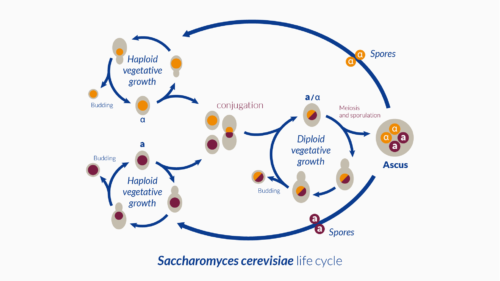
Natural habitat and adaptation strategies
Saccharomyces cerevisiae is widely distributed in nature, but whether it is truly a nomadic microbe or prefers specific ecological niches remains uncertain [6]. However, S. cerevisiae has been found in different natural environments, i.e., soil, forest plant surfaces (e.g., oak trees), and insect vectors. Its association with insects like wasps and Drosophila facilitates its distribution to new habitats, such as damaged fruits and wineries, contributing to its ecological success [7].
Industrial and commercial applications
Yeasts, such as Saccharomyces cerevisiae, can be genetically improved by several methods to optimize their performance in a wide range of applications. From classical selection to genetic engineering, different strain improvement approaches enable us to obtain better-adapted yeasts and explore their full potential in industrial and commercial applications.
Endless potential uses for yeast and yeast derivatives
By drawing on this knowledge of strains, growth media, and fermentation behavior, it is possible to optimize the expression of yeast’s numerous potential uses. For example, specific yeasts are more suited to sweet or sourdough recipes; others are more robust in frozen bread-making techniques. In the winemaking domain, inactive yeasts can be a source of nutrients to facilitate increasingly complicated fermentations in global warming. They are also helpful in preserving wine’s aromas and colors throughout the aging process.
Highly prized by the food industry, yeast extract is a natural culinary ingredient derived from S.cerevisiae yeast. Thanks to its wide range of aromatic notes, yeast extract enhances the taste of many sweet and savory foods. Yeast extracts are also an interesting solution for reducing salt or sugar in certain recipes to improve their nutritional profile.
Yeast extracts and peptones from Saccharomyces cerevisiae are used in industrial fermentation processes for the production of biomass and various metabolites. Integrated into growth media, these yeast-based nutrients are also sought-after in the manufacture of
Fermentation at the heart of our daily food habits
Today, the Saccharomyces cerevisiae yeast is widely produced and used in the food industry, due to its fermenting metabolism, its total innocuity, its rapid multiplication, its ease of use, and its nutritional benefits.
In bread-making, the strains of Saccharomyces cerevisiae are fermentation agents with an essential role. By partially consuming the flours’ sugar, they produce not only carbon dioxide and ethanol, which facilitate the increase in size during cooking, but also generate more than 200 molecules, which make up baked products’ sought-after aromas. The quantity of aromatic molecules produced varies according to the manufacturing parameters, and also the specific metabolism of the yeast strain used.
lactic ferments used by the dairy industry, and in the creation of diagnostic tests and vaccines in the pharmaceutical sector.
For our food security, yeast fractions rich in mannan-oligosaccharides and β-glucans (1,3 and 1,6) are also allies of choice in poultry production by diminishing the pressure of certain pathogens like E. coli or Salmonella.
From a sustainable farming perspective, Saccharomyces cerevisiae-based biofertilizers not only improve crop growth and nutrient uptake (e.g. phosphorus and nitrogen), but also act as a biocontrol agent against soil pathogens (e.g. mycotoxins, pathogenic fungi and bacteria), replacing the need for harmful chemicals.
Saccharomyces cerevisiae also increasingly recognized for its multiple applications, promoting and benefiting all aspects of a “One Health” approach [8].

Saccharomyces cerevisiae in food and beverage
Saccharomyces cerevisiae is used in the manufacture of many foods (bread, chocolate, coffee…) and fermented beverages (beer, kefir, kombucha…) thanks to its transformative power linked to alcoholic fermentation
Alcoholic fermentation is a biochemical process resulting from yeast enzymatic activity on the Embden-Meyerhof-Parnas pathway, also known as glycolysis, which leads to the conversion of glucose to pyruvate. Under anaerobic conditions, yeast then converts pyruvate to ethanol and CO₂[9].
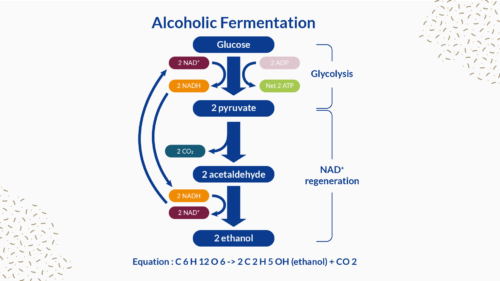
Let’s take a look at two key applications for Saccharomyces, particularly in food and beverages.
Bakery – The science of dough rising
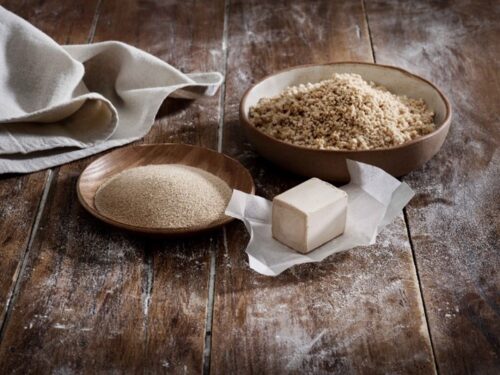
Also known as baker’s yeast, cerevisiae is the key ingredient in bread-making. Adapted to recipe and process constraints (low-sugar doughs, sweet doughs, frozen doughs, etc.), the selected yeast strains are recognized for their remarkable fermentation activity and their contribution in terms of taste and aroma. Saccharomyces cerevisiae is also an important component of the microbial ecosystem.
In the bread dough, S. cerevisiae will metabolize the sugars (glucose, fructose, maltose, sucrose, etc.) present in the flour and produce CO₂ in particular, causing the dough to expand. The ethanol also produced will be evaporated during baking. This bread fermentation will generate over 200 molecules which make up baked products’ sought-after aromas. The quantity of aromatic molecules produced varies according to manufacturing parameters and the specific metabolism of the yeast strain used.
Brewing – The role of yeast in alcoholic beverages
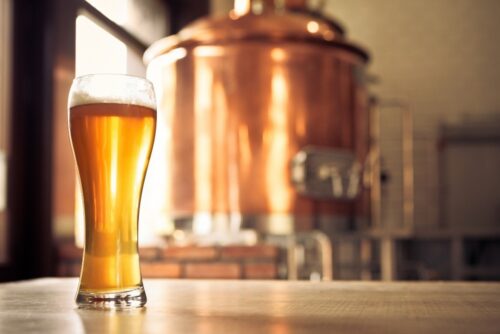
The dominant yeast species in the production of alcoholic beverages is Saccharomyces cerevisiae. Beer, the most widely consumed alcoholic beverage in the world, is produced by Saccharomyces yeast fermenting a wort composed of water, malted cereals (usually barley and wheat) and hops. Saccharomyces consumes sugars present in this brewing wort and converts them into ethanol and CO₂[9]. At the same time, hundreds of secondary metabolites that influence the beer’s aroma and taste are produced[10]. Whether for beer, wine or spirits (whisky, rum, gin…), selecting the right yeast strains is essential not only to maximize alcohol yield, but also to achieve the expected organoleptic qualities.
The bioethanol industry – Yeast as a sustainable fuel source
The yeast S.cerevisiae is one of the most efficient cell factories for the production of sustainable fuels. A distinction must be made between first-generation bioethanol and second-generation bioethanol.
- First-generation bioethanol production involves extracting fermentable sugars from food raw materials (sugar cane, beet, maize). In the case of corn, enzymatic hydrolysis of the starch is required to release glucose and maltose. These fermentable sugars are then metabolized by yeast into ethanol via alcoholic fermentation.
- The production of second-generation (2G) bioethanol involves non-food sources, notably lignocellulosic biomass waste, which will be processed by various technologies (thermal, chemical, etc.) to obtain hydolysates. These lignocellulosic biomass hydrolysates are complex substrates containing compounds that are toxic to yeast, and sugars such as pentoses that cannot be fermented by yeast. This is why 2G bioethanol production involves genetically modified strains of cerevisiae capable of fermenting pentoses such as xylose, and improving ethanol yields and tolerance to inhibitors.
Medical and health aspects of Saccharomyces cerevisiae
Is Saccharomyces cerevisiae beneficial or harmful to health?
Saccharomyces cerevisiae plays a key role as a probiotic yeast in intestinal health. S. cerevisiae var. boulardii is a probiotic yeast widely recognized for its efficacy in the treatment of gastrointestinal diseases. It helps to protect the normal gut microbiota and reduce the pathogenic effects of various diarrheal infections[11]. However, in immunocompromised or critically ill patients, Saccharomyces cerevisiae may act as an opportunistic pathogen and is therefore contraindicated[12].
Yeast allergies and autoimmune reactions
Yeast allergies and autoimmune reactions occur when the immune system mistakenly targets components of S. cerevisiae. In some cases, anti-S. cerevisiae antibodies are linked to autoimmune conditions such as Crohn’s disease, highlighting a potential link between yeast exposure and immune dysfunction [13]. It is important to understand, however, that yeast in food applications is not considered a major allergen.
Genetic and evolutionary perspectives
In recent decades, thousands of wild and domesticated strains of S. cerevisiae have been characterized phenotypically and genomically, providing new insights into the ecology, environmental adaptation, population structure, biogeography, evolution and natural and domestication history of the species [14].
Genomic evolution of Saccharomyces cerevisiae
The genetic diversity of Saccharomyces cerevisiae is primarily shaped by its wild populations, with China standing out as a hotspot for diversity. Studies suggest that ancient basal lineages of S. cerevisiae are found exclusively in China, supporting the ‘out-of-China’ hypothesis for its evolutionary origin [15].
The origin of domesticated S. cerevisiae remains unclear. However, strains collected from forests across different regions, including North America, Russia, Ecuador, Malaysia, and the Amazon, form unique genetic lineages, reflecting the species’ complex evolutionary history and global distribution.
Wild vs. domestic Saccharomyces cerevisiae
The history of yeast domestication began around 9,000 BC, as did that of the main plants and animals (around 10,000 years ago). The first evidence of wine-making dates back to 7000 BC, according to molecular analysis of pottery pots found in China.
Ecology seems to be the main driving force behind the evolution of S. cerevisiae. Interestingly, wild and domesticated strains have evolved distinct life strategies. Wild strains typically show higher genetic variation, differences in heterozygosity, and variations in sporulation rate and spore viability, adapting to their diverse natural environments [15]. Domesticated S. cerevisiae strains are heterozygous and adapted to fermentation environments, showing high-stress tolerance and strong maltose utilization—unlike wild strains, which are mostly homozygous and weak in maltose metabolism.
As with all domesticated organisms, the phenotypes of domesticated S. cerevisiae strains are a combination of improved selectable traits intrinsically present in S. cerevisiae (e.g. adaptation to sugar-rich, oxygen-poor environments and high ethanol tolerance), and traits acquired through interaction with man (e.g. efficient maltotriose utilization in brewer’s yeast) [16].
Genome sequence data for over 3,000 strains of S. cerevisiae have been made public. These strains come from a total of 94 countries or regions of the world[17]. The ecological origins of the strains are diverse: wine, beer, Chinese mantou, bread, chocolate, oak, fruit, insects, soil…
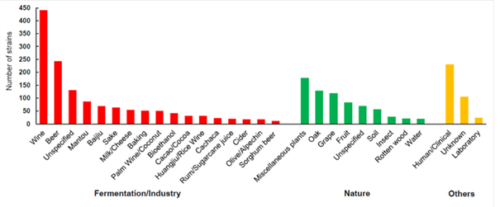
The future of Saccharomyces cerevisiae in biotechnology
New genetic technologies, in particular CRISPR-Cas gene-editing systems, and their ease of application in S. cerevisiae, have opened up previously unimaginable metabolic engineering possibilities. Combined with discoveries in yeast physiology and biochemistry, this knowledge has enabled the easy rational manipulation of the yeast genome, propelling its status from that of a useful natural resource to that of a versatile technological platform.
Can yeast replace meat? The role of S. cerevisiae in alternative proteins
Saccharomyces cerevisiae is fast becoming a key player in the alternative protein industry. Yeast is intrinsically rich in proteins of high nutritional value [18]. Saccharomyces cerevisiae naturally contains 49% protein (on a dry matter basis). Highly digestible, Saccharomyces cerevisiae complete proteins offer a sustainable alternative to traditional meat.
Thanks to precision fermentation (PF), Saccharomyces yeast can be programmed by strain engineering to produce sustainable protein ingredients corresponding to proteins traditionally derived from animals or plants [19(]), such as casein (milk), collagen (meat), ovalbumin (egg) or brazein (plant). Genetically modified or advanced yeasts can now help the agri-food industry to improve the functionality and nutritional characteristics of foodstuffs, while addressing environmental and animal welfare concerns. The production of these alternative proteins is similar to enzymatic biomanufacturing, which generates biocatalytic processing aids for the food industry.
Synthetic biology – Can we create a super yeast?
Synthetic biology aims to redesign and optimize organisms so that they perform specific processes more efficiently. Today, yeasts are considered attractive microbial cell factories for the production of a wide range of high value-added and sustainable products, such as biofuels, pharmaceuticals, agrochemicals, fragrances, additives, pigments, etc. Synthetic biology techniques are capable of transforming every cell into a robust “super-factory” capable of producing molecules of interest at high titres, rates and yields
Frequently asked questions (FAQ)
What does Saccharomyces cerevisiae do for your body?
Saccharomyces cerevisiae can have different effects on the human body, depending on its form and use. Several strains of Saccharomyces cerevisiae vs boulardii yeast, such as Saccharomyces boulardii CNCM I-3856, act as probiotics. As such, probiotic yeasts are living micro-organisms that play a crucial role in improving digestive health by protecting and preserving the intestinal microbiota. They also boost immune function by stimulating the body’s natural defenses and promoting a balanced immune response.
Inactivated Saccharomyces cerevisiae yeasts in nutritional yeast form can also act as a nutritional food for the human body, providing a natural source of essential nutrients, including fiber, vitamins, proteins and minerals
Rich in polysaccharides such as manans and β-glucans, S.cerevisiae yeast walls or fractions thereof have prebiotic potential, enhancing the growth and activity of health-promoting bacteria and contributing to the proper functioning of the immune system.
Is Saccharomyces cerevisiae a bacterium or a virus?
Saccharomyces cerevisiae is a unicellular fungus belonging to the Ascomycetes (Ascomycota) phylum. Saccharomyces cerevisiae yeasts are eukaryotic organisms, unlike bacteria and viruses.
Can Saccharomyces cerevisiae cause infections?
In rare cases, it can cause opportunistic infections in people with weakened immune systems.
How is Saccharomyces cerevisiae used in medicine?
In medicine, S.cerevisiae vs boulardii yeast is a recognized antidiarrheal that helps restore intestinal flora. It is used in the adjunctive treatment of diarrhea, as a complement to dietary measures.
In addition to being used to produce recombinant pharmaceutical products such as insulin, the yeast Saccharomyces cerevisiae has today become an essential therapeutic and prophylactic aid, thanks to advances in genetic engineering. Applications of genetically modified S. cerevisiae cells in medicine[20] include the production of :
- Molecules of therapeutic interest (growth hormone, hydrocortisone, etc.)
- Recombinant immunogenic proteins for vaccines
- Yeast-based biosensors for identifying target molecules or environmental signals
- Living biotherapeutic products to prevent or treat diseases and metabolic imbalances in the human body.
What role does Saccharomyces cerevisiae play in fermentation?
During the fermentation process, Saccharomyces cerevisiae metabolizes sugars into ethanol and CO2.
Conclusion
Saccharomyces cerevisiae is a remarkable single-cell microorganism that profoundly impacts science, industry, and health. From its role in fermentation to its potential in biotechnology, this yeast continues to shape our world. As research advances, its applications will further expand, offering new solutions to global challenges.
References
[1] Goffeau, A., Barrell, B.G., Bussey, H., Davis, R.W., Dujon, B., Feldmann, H., Galibert, F., Hoheisel, J.D., Jacq, C., Johnston, M. and Louis, E.J., 1996. Life with 6000 genes. Science, 274(5287), pp.546-567.
[2] Wood, V.K.M.R., Rutherford, K.M., Ivens, A., Rajandream, M.A. and Barrell, B., 2001. A re-annotation of the Saccharomyces cerevisiae genome. Comparative and Functional Genomics, 2(3), pp.143-154.
[3] Karathia, H., Vilaprinyo, E., Sorribas, A. and Alves, R., 2011. Saccharomyces cerevisiae as a model organism: a comparative study. PloS one, 6(2), p.e16015.
[4] Stéphane Bach, Pierre Colas, Marc Blondel-Budding yeast, a model and a tool… also for biomedical research, Med Sci (Paris) 36 (5) 504-514 (2020) – DOI: 10.1051/medsci/2020077
[5] Duina, A.A., Miller, M.E. and Keeney, J.B., 2014. Budding yeast for budding geneticists: a primer on the Saccharomyces cerevisiae model system. Genetics, 197(1), pp.33-48.
[6] Gallone, B., Mertens, S., Gordon, J.L., Maere, S., Verstrepen, K.J. and Steensels, J., 2018. Origins, evolution, domestication and diversity Saccharomyces beer yeasts. Current opinion in biotechnology, 49, pp.148-155.
[7] Parapouli, M., Vasileiadis, A., Afendra, A.S. and Hatziloukas, E., 2020. Saccharomyces cerevisiae and its industrial applications. AIMS microbiology, 6(1), pp. 1-31.
[8] Ballet, N.; Renaud, S.; Roume, H.; George, F.; Vandekerckove, P.; Boyer, M.; Durand-Dubief, M. Saccharomyces cerevisiae: Multifaceted Applications in One Health and the Achievement of Sustainable Development Goals. Encyclopedia 2023, 3, 602-613. https://doi.org/10.3390/encyclopedia3020043
[9] Iorizzo, M.; Coppola, F.; Letizia, F.; Testa, B.; Sorrentino, E. Role of Yeasts in the Brewing Process: Tradition and Innovation. Processes 2021, 9, 839. https://doi.org/10.3390/pr9050839
[10] Maicas S. The Role of Yeasts in Fermentation Processes. Microorganisms. 2020 Jul 28;8(8):1142. doi: 10.3390/microorganisms8081142. PMID: 32731589; PMCID: PMC7466055.
[11] Abid, R., Waseem, H., Ali, J., Ghazanfar, S., Muhammad Ali, G., Elasbali, A.M. and Alharethi, S.H., 2022. Probiotic yeast Saccharomyces: Back to nature to improve human health. Journal of Fungi, 8(5), p.444.
[12] Munoz, P., Bouza, E., Cuenca-Estrella, M., Eiros, J.M., Pérez, M.J., Sánchez-Somolinos, M., Rincón, C., Hortal, J. and Peláez, T., 2005. Saccharomyces cerevisiae fungemia: an emerging infectious disease. Clinical infectious diseases. Clinical infectious diseases, 40(11), pp.1625-1634.
[13] Rinaldi, M., Perricone, R., Blank, M., Perricone, C. and Shoenfeld, Y., 2013. Anti-Saccharomyces cerevisiae autoantibodies in autoimmune diseases: from bread baking to autoimmunity. Clinical reviews in allergy & immunology, 45, pp.152-161.
[14] Bai, F.Y., Han, D.Y., Duan, S.F. and Wang, Q.M., 2022. The ecology and evolution of the Baker’s Yeast Saccharomyces cerevisiae. Genes, 13(2), p.230.
[15] Fay, J.C. and Benavides, J.A., 2005. Evidence for domesticated and wild populations of Saccharomyces cerevisiae. PLoS genetics, 1(1), p.e5.
[16] Brigida Gallone, Stijn Mertens, Jonathan L Gordon, Steven Maere, Kevin J Verstrepen, Jan Steensels, Origins, evolution, domestication and diversity of Saccharomyces beer yeasts, Current Opinion in Biotechnology, Volume 49, 2018, Pages 148-155, https://doi.org/10.1016/j.copbio.2017.08.005
[17] Victor Loegler, Anne Friedrich, Joseph Schacherer, Overview of the Saccharomyces cerevisiae population structure through the lens of 3,034 genomes, G3 Genes|Genomes|Genetics, Volume 14, Issue 12, December 2024, jkae245, https://doi.org/10.1093/g3journal/jkae245
[18] Junrui Ma, Yifei Sun, Demei Meng, Zhongkai Zhou, Yuyu Zhang, Rui Yang, Yeast proteins: The novel and sustainable alternative protein in food applications, Trends in Food Science & Technology, Volume 135, 2023, Pages 190-201, https://doi.org/10.1016/j.tifs.2023.04.003.
[19] J. Lucas Eastham, Adam R. Leman, Precision fermentation for food proteins: ingredient innovations, bioprocess considerations, and outlook – a mini-review, Current Opinion in Food Science,Volume 58, 2024,101194, https://doi.org/10.1016/j.cofs.2024.101194.
[20] Maneira et al. Engineering Saccharomyces cerevisiae for medical applications. Microb Cell Fact 24 , 12 (2025). https://doi.org/10.1186/s12934-024-02625-5


